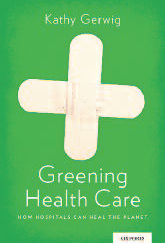SEJournal Online is the digital news magazine of the Society of Environmental Journalists. Learn more about SEJournal Online, including submission, subscription and advertising information.

BookShelf
"Greening Health Care: How Hospitals Can Heal the Planet"
By Kathy Gerwig
Oxford University Press, $27.95
Reviewed by JIM MOTAVALLI
“Greening Health Care: How Hospitals Can Heal the Planet” is an important book that could have far-reaching implications for the American health-care industry.
People concerned about the escalating costs of going to the doctor — that includes just about all of us — should read it.
So should hospital officials. They could benefit from the book’s recommendations — not only to help green their operations, but also to potentially save more money.
The book’s author, Kathy Gerwig, isn’t a journalist. She’s a front-line soldier in the fight, as a vice president of Kaiser Permanente, a big nonprofit health-care provider.
Together with companies such as Johnson & Johnson and organizations such as Practice Greenhealth or Health Care Without Harm, KP is finding out what actually works.
Many of the ideas here represent fruit so low-hanging it’s practically on the ground.
Gerwig imagines a total-health hospital with an environment that doesn’t make you sicker than when you came in — with renewable energy generation, convenient transit stops and porous pavement in the parking lot; native plantings, environmentally friendly carpets and flooring; PVC-free IV bags and Energy Star machines; natural light, fresh food, water-conserving toilets and sinks, and natural cleaning products.
A farmer’s market in the shadow of solar panels? Why not?
Hospitals such as this actually exist — Gundersen Health System in Wisconsin, for instance, does much of the above, and it’s also been energy independent since 2014, thanks to everything from wind turbines to biomass boilers.
Gerwig’s book makes the business case for green, citing a recent study that states, “If the health care industry conserved energy, reduced waste, and more efficiently purchased operating supplies, it could save more than $15 billion over 10 years.”
She’s particularly good at promoting waste reduction, including the expensive-to-process “red bag” stuff. By avoiding the landfill with reduce, reuse and recycle programs, hospitals could reduce their operating expenses by almost 20 percent, according to the book.
Did you know that operating rooms produce as much as 30 percent of all hospital waste?
A lot of that waste is single-use disposable instruments. One way hospitals are saving money is by switching to perfectly safe — but only recently available — recycled alternatives. But such changes take time.
More examples of how patients were helped through combined wellness and environmental programs would have been welcome. But this isn’t a book aimed at general readers. It’s more a blueprint for a hospital makeover. If you see its bright green cover at your local nurse’s station, you’ll know that sustainability is on the agenda.
Jim Motavalli is a Connecticut-based SEJ member, author and freelancer whose articles have appeared in various publications over the years, including The New York Times. He has written extensively about the automotive industry.
* From the quarterly newsletter SEJournal, Spring 2015. Each new issue of SEJournal is available to members and subscribers only; find subscription information here or learn how to join SEJ. Past issues are archived for the public here.













 Advertisement
Advertisement 



